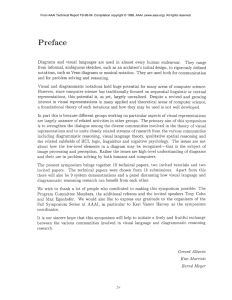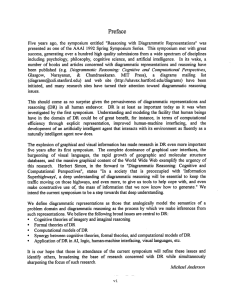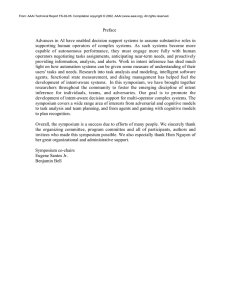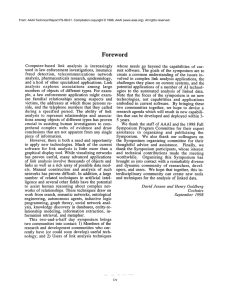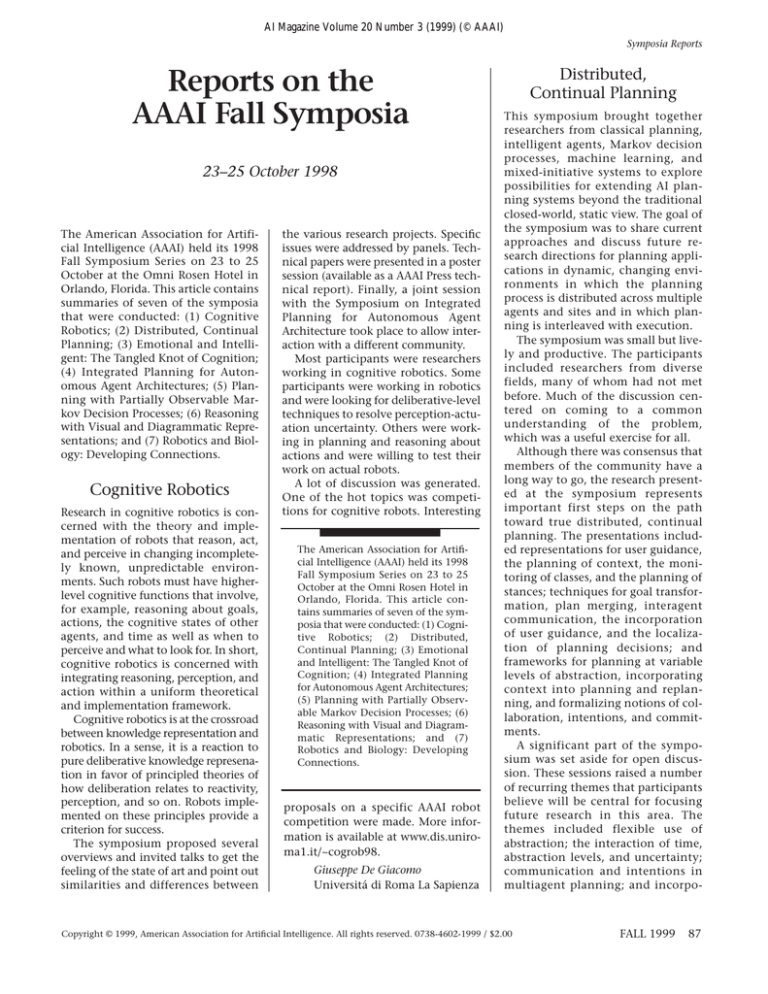
AI Magazine Volume 20 Number 3 (1999) (© AAAI)
Symposia Reports
Reports on the
AAAI Fall Symposia
23–25 October 1998
The American Association for Artificial Intelligence (AAAI) held its 1998
Fall Symposium Series on 23 to 25
October at the Omni Rosen Hotel in
Orlando, Florida. This article contains
summaries of seven of the symposia
that were conducted: (1) Cognitive
Robotics; (2) Distributed, Continual
Planning; (3) Emotional and Intelligent: The Tangled Knot of Cognition;
(4) Integrated Planning for Autonomous Agent Architectures; (5) Planning with Partially Observable Markov Decision Processes; (6) Reasoning
with Visual and Diagrammatic Representations; and (7) Robotics and Biology: Developing Connections.
Cognitive Robotics
Research in cognitive robotics is concerned with the theory and implementation of robots that reason, act,
and perceive in changing incompletely known, unpredictable environments. Such robots must have higherlevel cognitive functions that involve,
for example, reasoning about goals,
actions, the cognitive states of other
agents, and time as well as when to
perceive and what to look for. In short,
cognitive robotics is concerned with
integrating reasoning, perception, and
action within a uniform theoretical
and implementation framework.
Cognitive robotics is at the crossroad
between knowledge representation and
robotics. In a sense, it is a reaction to
pure deliberative knowledge represenation in favor of principled theories of
how deliberation relates to reactivity,
perception, and so on. Robots implemented on these principles provide a
criterion for success.
The symposium proposed several
overviews and invited talks to get the
feeling of the state of art and point out
similarities and differences between
the various research projects. Specific
issues were addressed by panels. Technical papers were presented in a poster
session (available as a AAAI Press technical report). Finally, a joint session
with the Symposium on Integrated
Planning for Autonomous Agent
Architecture took place to allow interaction with a different community.
Most participants were researchers
working in cognitive robotics. Some
participants were working in robotics
and were looking for deliberative-level
techniques to resolve perception-actuation uncertainty. Others were working in planning and reasoning about
actions and were willing to test their
work on actual robots.
A lot of discussion was generated.
One of the hot topics was competitions for cognitive robots. Interesting
The American Association for Artificial Intelligence (AAAI) held its 1998
Fall Symposium Series on 23 to 25
October at the Omni Rosen Hotel in
Orlando, Florida. This article contains summaries of seven of the symposia that were conducted: (1) Cognitive Robotics; (2) Distributed,
Continual Planning; (3) Emotional
and Intelligent: The Tangled Knot of
Cognition; (4) Integrated Planning
for Autonomous Agent Architectures;
(5) Planning with Partially Observable Markov Decision Processes; (6)
Reasoning with Visual and Diagrammatic Representations; and (7)
Robotics and Biology: Developing
Connections.
proposals on a specific AAAI robot
competition were made. More information is available at www.dis.uniroma1.it/~cogrob98.
Giuseppe De Giacomo
Universitá di Roma La Sapienza
Distributed,
Continual Planning
This symposium brought together
researchers from classical planning,
intelligent agents, Markov decision
processes, machine learning, and
mixed-initiative systems to explore
possibilities for extending AI planning systems beyond the traditional
closed-world, static view. The goal of
the symposium was to share current
approaches and discuss future research directions for planning applications in dynamic, changing environments in which the planning
process is distributed across multiple
agents and sites and in which planning is interleaved with execution.
The symposium was small but lively and productive. The participants
included researchers from diverse
fields, many of whom had not met
before. Much of the discussion centered on coming to a common
understanding of the problem,
which was a useful exercise for all.
Although there was consensus that
members of the community have a
long way to go, the research presented at the symposium represents
important first steps on the path
toward true distributed, continual
planning. The presentations included representations for user guidance,
the planning of context, the monitoring of classes, and the planning of
stances; techniques for goal transformation, plan merging, interagent
communication, the incorporation
of user guidance, and the localization of planning decisions; and
frameworks for planning at variable
levels of abstraction, incorporating
context into planning and replanning, and formalizing notions of collaboration, intentions, and commitments.
A significant part of the symposium was set aside for open discussion. These sessions raised a number
of recurring themes that participants
believe will be central for focusing
future research in this area. The
themes included flexible use of
abstraction; the interaction of time,
abstraction levels, and uncertainty;
communication and intentions in
multiagent planning; and incorpo-
Copyright © 1999, American Association for Artificial Intelligence. All rights reserved. 0738-4602-1999 / $2.00
FALL 1999
87
Symposia Reports
The final “moral” could be summarized as, When
engineering artifacts, we should not put in them more
emotion than what is required by the complexity of the
system-environment interaction.
rating utilities, priorities, and soft
constraints in planning and execution.
Marie desJardins
SRI International
Emotional and Intelligent:
The Tangled Knot of
Cognition
This multidisciplinary symposium
brought together researchers in artificial and human emotions in an effort
to investigate the roles that emotions
play in grounding intelligent behavior
and the possibilities for cross-fertilization between theoretical and engineering approaches to the study of
emotion.
Presentations
were
organized
around seven main topics: (1) emotion, cognition, and learning; (2)
architectures for emotion; (3) emotion
in social interaction; (4) emotion
expression and recognition; (5) psychological models of emotion; (6)
emotion in arts and entertainment;
and (7) theoretical issues. Lively discussions took place at the end of each
session and were furthered in small
working group meetings.
The last session was devoted to
identifying open problems and issues
to be taken into account when designing artificial systems endowed with
(some aspects of) emotions. Consensus was reached on several ideas,
including the following:
First, the degree of complexity of
emotional phenomena that is meaningful to model within an AI system
strongly depends on whether our concern is an engineering or a scientific
one.
Second, the designers of artificial
systems cannot assume the adaptive
character of emotions only on the
grounds of biological evidence. The
contributions of emotions must be
shown by our results and carefully
evaluated.
88
AI MAGAZINE
Third, the design must be guided by
the requirements on the system and
on the interactions with its particular
environment, and our architectures
must be related with the desired functions.
The final “moral” could be summarized as, When engineering artifacts,
we should not put in them more emotion than what is required by the complexity of the system-environment
interaction.
Dolores Canamero
Technical University of
Catalonia and IIIA,
Spanish Scientific Research
Council
Integrated Planning
for Autonomous
Agent Architectures
The Integrated Planning for Autonomous Agent Architectures symposium was intended to address two primary questions: (1) what do robots
need to plan and (2) how should this
planning be integrated with their
architectures?
Regarding the first question, participants decided that for many domains,
planning is not necessary for a robot
in part because most existing robots
do not have a particularly rich set of
interactions with the world. We speculated that planning will be more useful for future robots with larger action
sets. We sought to identify characteristics of domains where planning does
appear to be useful. These domains
can possess low observability, irreversible actions, multiagents, or conflicting goals. The question of a
domain’s observability was particularly interesting because it asserts that a
richer sensor suite reduces the need for
planning, which was demonstrated by
Carnegie Mellon University’s tour-giving robot SAGE. Also of interest was the
idea that experimentation (trial and
error) can be a viable alternative to
planning in certain situations.
Regarding the second question, we
decided that in domains where planning is important, it should not necessarily be done the “classical” way. That
is, planning is a process by which an
execution architecture can be provided with imperfect but useful information. Planning needs to be evaluated
by trade-offs between the information
gained and the computational effort
required. Ideas we discussed for integrating planning into an agent architecture included using limited planning horizons, using anytime
planning, accepting suboptimal plans,
and maintaining planning abstractions for as long as possible.
Glenn Wasson
University of Virginia
Planning with Partially
Observable Markov
Decision Processes
In recent years, there has been growing interest among researchers in AI,
psychology, engineering, and other
areas in a mathematical model for
planning. The model, developed in
the 1960s and 1970s by the operations
research community, is an elegant formalism for describing and solving
sequential decision problems in
stochastic domains where there is hidden state. The main purpose of the
symposium on Planning with Partially
Observable Markov Decision Processes
(POMDPs) was to gather interested
researchers from these different disciplines to discuss current and future
research issues.
A highlight of the symposium was
the presence of researchers from outside AI who shared their unique views
and perspectives. Two researchers
involved in the early ground-breaking
work on the POMDP model provided
comments and suggestions that were
extremely valuable for placing recent
POMDP developments into perspective; the increased speed of computers
and our improved understanding of
computational and algorithmic issues
are two of the main new tools AI
researchers bring to the table. From
the field of psychology, we heard how
the POMDP model relates to classical
Symposia Reports
animal-learning experiments (for
example, pigeons pecking for food).
The ensuing discussion was one of the
highlights of the symposium and one
that clearly warrants further exploration.
From within the computer science
community, there was representation
from a broad range of research areas.
We discussed how generalizations and
specializations of the POMDP model,
driven by the concerns of robotics and
other applications, affect planning,
learning, and computational complexity. Interesting POMDP variations,
including models with a continuous
representation of time, models with a
risk-sensitive optimality criterion, and
reinforcement learning models were
discussed and found to be far less complex than many of us originally
thought. This realization will likely
influence future research in POMDP
applications and algorithms.
Overall, it was satisfying that many
connections between researchers in
different disciplines and subfields were
made. Because this was the first organized meeting of POMDP-oriented
researchers, many of the attendees
were grateful for the opportunity to
meet and learn from their colleagues.
A series of exciting and fruitful collaborations from the attendees can be
expected in the years to come.
Michael Littman
Duke University
Reasoning with Visual
and Diagrammatic
Representations
Diagrammatic languages are ubiquitous in almost every human endeavor:
Virtually all technical disciplines use
diagrammatic notations, and nontechnical fields use their own diagrammatic systems, for example, choreography notation.
Consequentially, visual humancomputer interfaces have become
standard. However, these interfaces
rarely exploit the rich structure and
complex semantics of diagrammatic
languages. To envision intelligent diagrammatic interfaces, new ways of
interpreting and manipulating diagrammatic notations on a high level
of abstraction need to be devised.
This challenge was taken up by the
Symposium on Reasoning with Visual
and Diagrammatic Representations.
Previously, work on these topics has
been carried out by largely unconnected groups in such diverse fields as AI,
visual languages, spatial reasoning,
and other neighboring disciplines.
The primary aim of the symposium,
therefore, was to strengthen the dialogue among these communities, and
as expected, it attracted contributions
and participation from a number of
different fields.
Among the most actively discussed
questions were foundational issues;
for example, What distinguishes diagrammatic representations from other
types of visual representations? Does
diagrammatic reasoning require different, new modes of processing that are
essentially diagrammatic in nature?
More technically oriented questions
regarding the analysis of diagrammatic systems and of formal methods for
interpreting and manipulating diagrammatic notations were discussed
in 10 contributed papers, 2 invited
tutorials, and 2 invited papers. Nine
system demonstrations and a panel
discussing how visual language and
diagrammatic reasoning research can
benefit from each other completed the
program.
It is our sincere hope that the fruitful exchange initiated here will be
continued in subsequent events.
Gerard Allwein
Indiana University
Kim Marriott
Monash University
Bernd Meyer
University of Munich
Robotics and Biology:
Developing Connections
There is a growing body of work developing at the intersection of biology
and robotics. In particular, robotic systems are being built that are not merely biologically inspired but designed as
accurate models of particular biological systems. The performance of these
systems can thus be used directly to
evaluate biological hypotheses as well
as to test how well biological mecha-
nisms perform as robot controllers.
This symposium was a gathering of
researchers working in this area. There
was substantial variety in research
backgrounds and systems studied
(from ants to humans). Nevertheless,
there emerged a consensus about the
research methods leading to the most
productive advances:
First is modeling a specific animal,
for example, a cockroach-based walking machine, as opposed to generic
animal-like designs. A target animal
usefully constrains and focuses both
the design of the robot and the experiments to be performed. Thus, the
potential for mapping robot results
back to the biology is increased, setting up a research interaction rather
than a one-way flow of ideas.
Second is building a physical system, for example, an underwater robot
to model lobster chemotaxis. Simulation can be a useful preliminary step
but cannot replace real-world testing
in evaluating sensorimotor systems
that must deal with complex environments. Physical systems are useful for
discovering the critical factors in environments that have direct application
in biological research. This methodology also raises a number of serious
issues for technological development,
such as muscle-like actuators.
Third is testing the system by replicating the experimental conditions
used for testing the animal, which
exploits the many well-developed
methodologies for behavior evaluation that already exist in biology, for
example, directly replacing the fly in a
flight simulator with an analog VLSI
circuit modeling the fly’s optomotor
response.
Potential collaborations and identification of areas of biology with good
potential for applying this approach
were among the results to emerge
from this symposium, pointing to a
strong future for this field.
Barbara Webb
University of Nottingham
Tom Consi
Massachusetts Institute of
Technology
FALL 1999
89

